GMC SAVANA 1996 User Guide
Manufacturer: GMC, Model Year: 1996, Model line: SAVANA, Model: GMC SAVANA 1996Pages: 372, PDF Size: 18.81 MB
Page 11 of 372
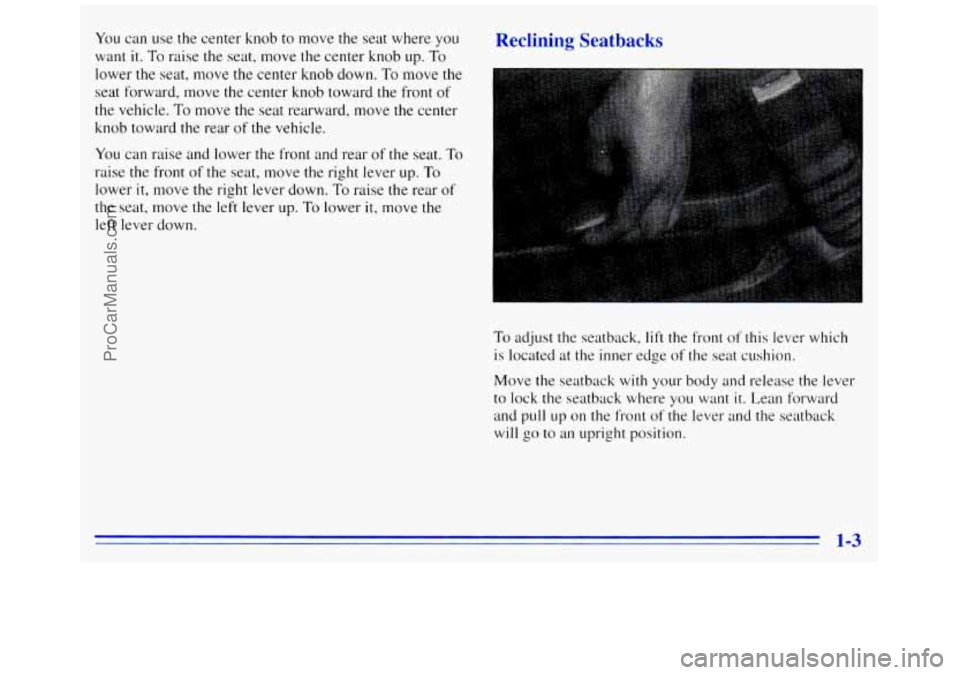
You can use the center knob to move the seat where you
want it. To raise the seat, move the center knob up. To
lower the seat, move the center knob down. To move the
seat forward, move the center knob toward the front of
the vehicle. To move the seat rearward, move the center
knob toward the rear
of the vehicle.
You can raise and lower the front and rear of the seat. To
raise the front of the seat, move the right lever up. To
lower it, move the
the seat, move the
left lever down. right
lever down. To raise the rear of
left lever up. To lower it, move the
Reclining Seatbacks
To adjust the seatback, lift the front of this lever which
is located
at the inner edge of the seat cushion.
Move the seatback
with your body and release the lever
to lock the seatback where you want
it. Lean forward
and
pull up on the front of the lever and the seatback
will
go to an upright position.
1-3
-.-
ProCarManuals.com
Page 12 of 372
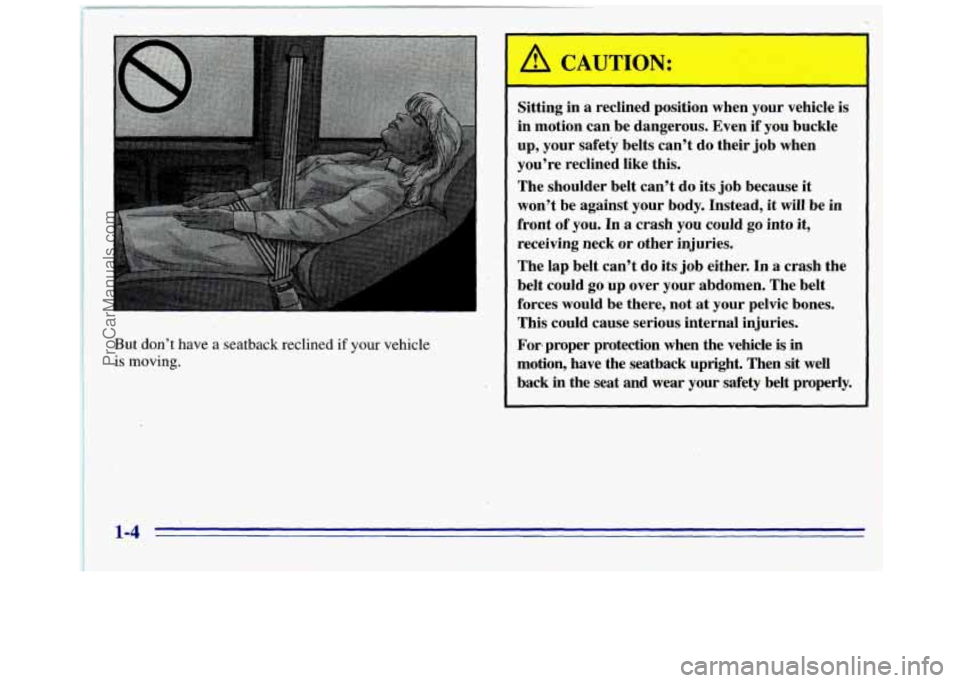
But don’t have a seatback reclined if your vehicle
is moving.
I
I
Sitting in a reclined position when your vehicle is
in motion can be dangerous. Even
if you buckle
up, ,your safety belts can’t do their job when
you’re reclined like this.
The shoulder belt can’t
do its job because it
won’t be against your body. Instead, it wiILbe in
front of you. In a crash you could go into it,
receiving neck
or other injuries.
The lap belt can’t
do its job either. In a‘iii3sh the
belt could
go up over your abdomen. The belt
forces would be there, not at your pelvic bones.
This could cause serious internal injuries.
For proper protection when the vehicle is in
motion, have the seatback upright. Then
sit well
back
in the seat and wear your safety belt properly.
I
ProCarManuals.com
Page 13 of 372
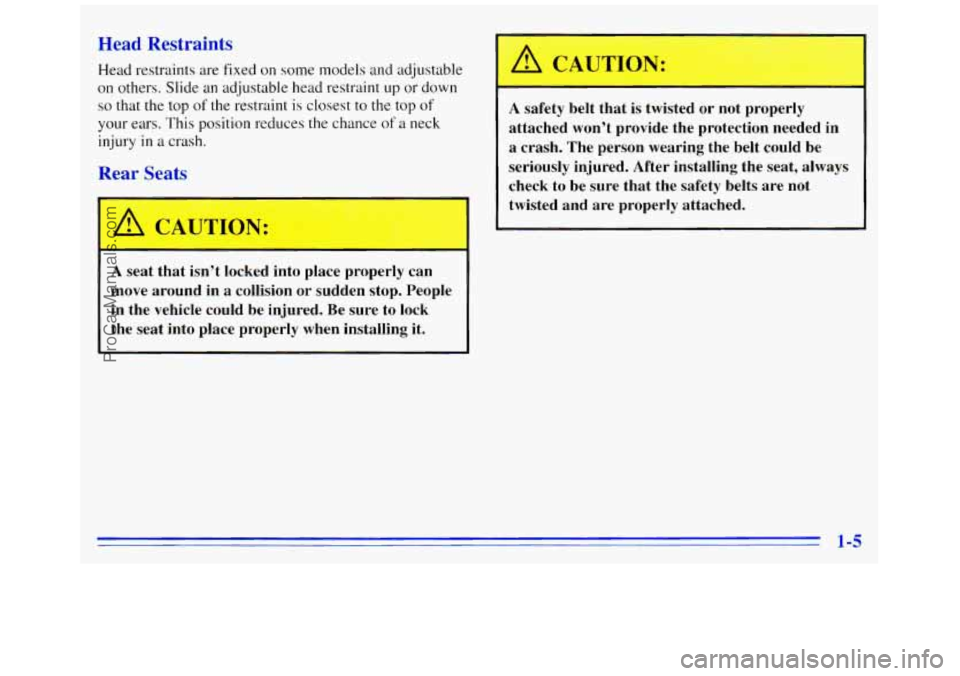
Head Restraints
Head restraints are fixed on some models and adjustable
on others. Slide an adjustable head restraint up or down
so that the top of the restraint is closest to the top of
your ears. This position reduces the chance of a neck
injury
in a crash.
Rear Seats
A seat that isn’t locked into place properly can
move around in a collision or sudden stop. People
in the vehicle could be injured. Be sure to lock
the seat into place properly when installing it.
I
A safety belt that is twisted or not properly
attached won’t provide the protection needed in
a crash. The person wearing the belt could be
seriously injured. After installing the seat, always
check to be sure that the safety belts are not
twisted and are properly attached.
ProCarManuals.com
Page 14 of 372
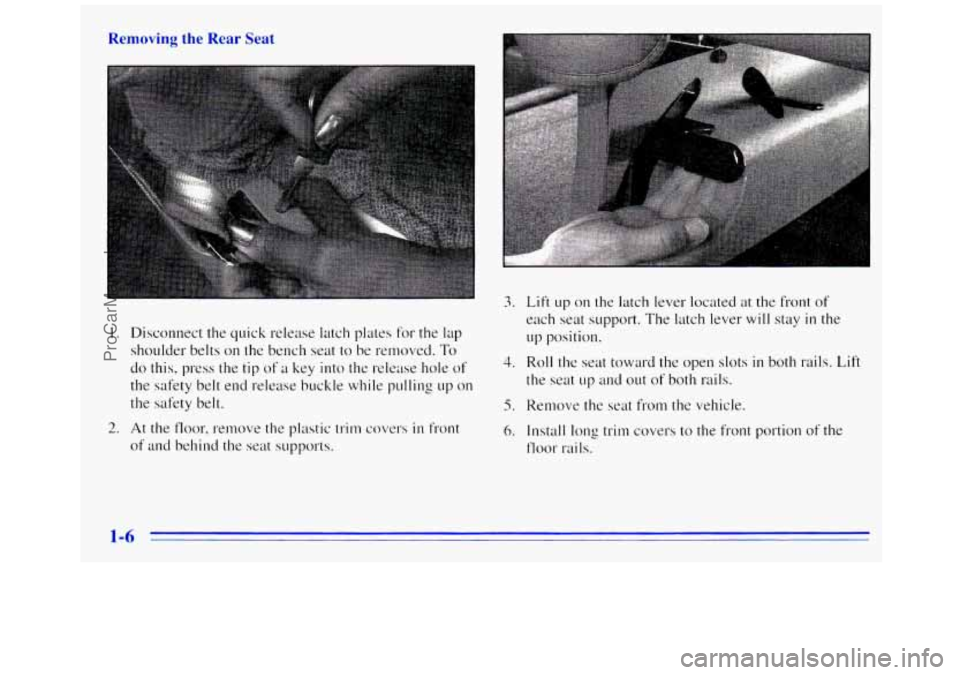
Removing the Rear Seat
I. Disconnect the quick release latch plates for the lap
shoulder belts
on the bench seat to be re~noved. To
do this, press the tip of a key into the elea ease hole of
the safety belt end release buckle while pulling
up on
the safety belt.
2. At the floor, rell~ove the plastic trim covers in front
of and behind the seat supports.
3. Lift up on the latch lever located at the front of
each seat support. The latch lever will stay in the
up position.
4. Roll the seat toward the open slots in both rails. Lift
the seat up and out of both rails.
5. Remove the seat from the vehicle.
6. Install long trim covers to the front portion of the
floor
rails.
1-6
ProCarManuals.com
Page 15 of 372
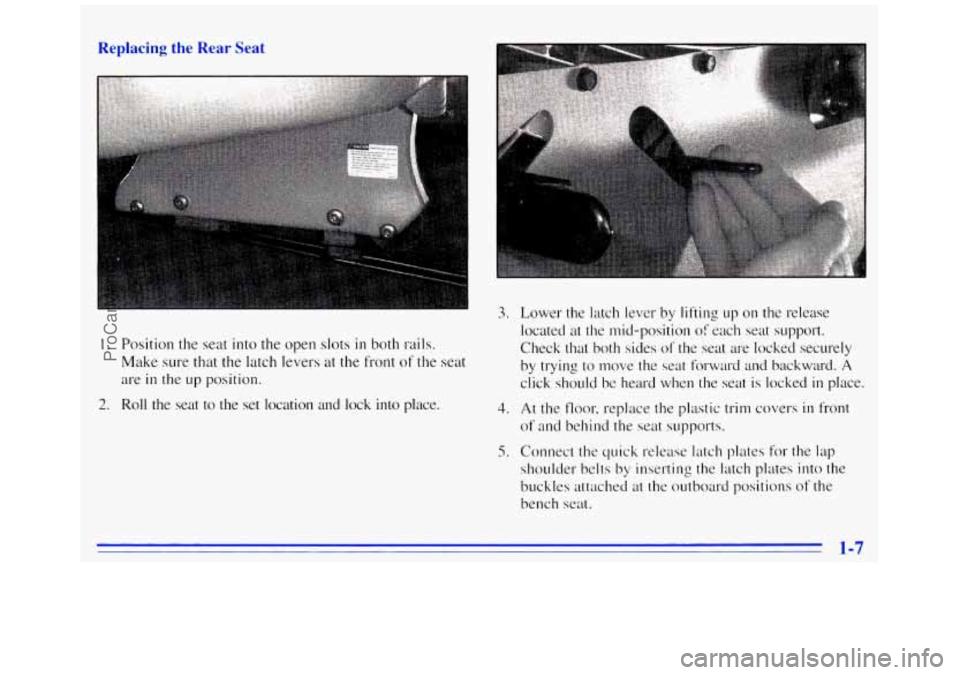
Replacing the Rear Seat
1. Position the seat into the open slots in both rails.
Make sure that the latch levers at the front of the seat
are in the up position.
2. Roll the seat to the set location and lock into place.
3. Lower the latch 1eve.r by lifting up on the release
located at the mid-position
of each seat support.
Check
that both sides of the seat are locked securely
by trying
to move the seat forward and backward. A
click should be heard when the seat is locked in place.
4. At the floor, replace the plastic trim covers in front
of and behind the seat supports.
5. Connect the quick release latch plates for the lap
shoulder belts by inserting the latch plates into the
buckles attached at the outboard positions of the
bench
seat.
1-7
ProCarManuals.com
Page 16 of 372
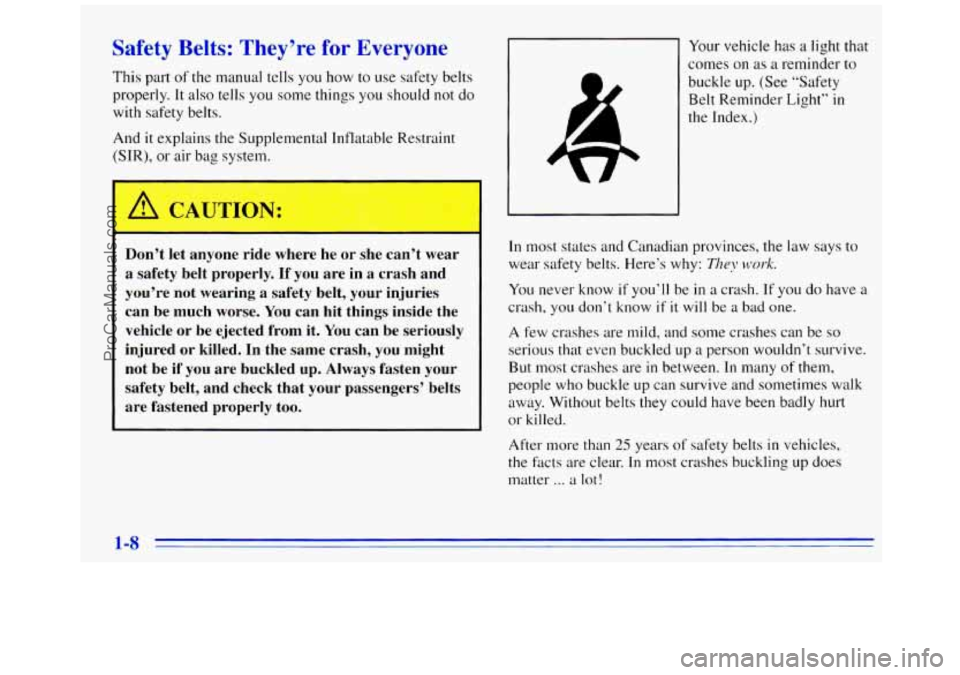
Safety Belts: They’re for Everyone
This part of the manual tells you how to use safety belts
properly. It also tells you some things you should not do
with safety belts.
And it explains the Supplemental Inflatable Restraint
(SIR), or air bag system.
I
6b, CAC I‘ION:
Don’t let anyone ride where he or she can’t wear
a safety belt properly. If you are in a crash and
you’re not wearing a safety belt, your injuries
can be much worse. You can hit things inside the
vehicle or be ejected from it.
You can be seriously
injured or killed. In the same crash, you might
not be
if you are buckled up. Always fasten your
safety belt, and check that your passengers’ belts
are fastened properly too. Your
vehicle has a light that
comes on as a reminder to
buckle up. (See “Safety
Belt Reminder Light’’
in
the Index.)
In most states and Canadian provinces, the law says to
wear safety belts. Here’s why: They bvork.
You never know if you’ll be in a crash. If you do have a
crash, you don’t know
if it will be a bad one.
A few crashes are mild, and some crashes can be so
serious that even buckled up a person wouldn’t survive.
But most crashes are
in between. In many of them,
people who buckle up can survive and sometimes walk
away. Without belts they could have been badly hurt
or killed.
After more than 25 y&IB of safety belts in vehicles,
the facts are clear. In most crashes buckling
up does
matter
... a lot!
1-8
ProCarManuals.com
Page 17 of 372
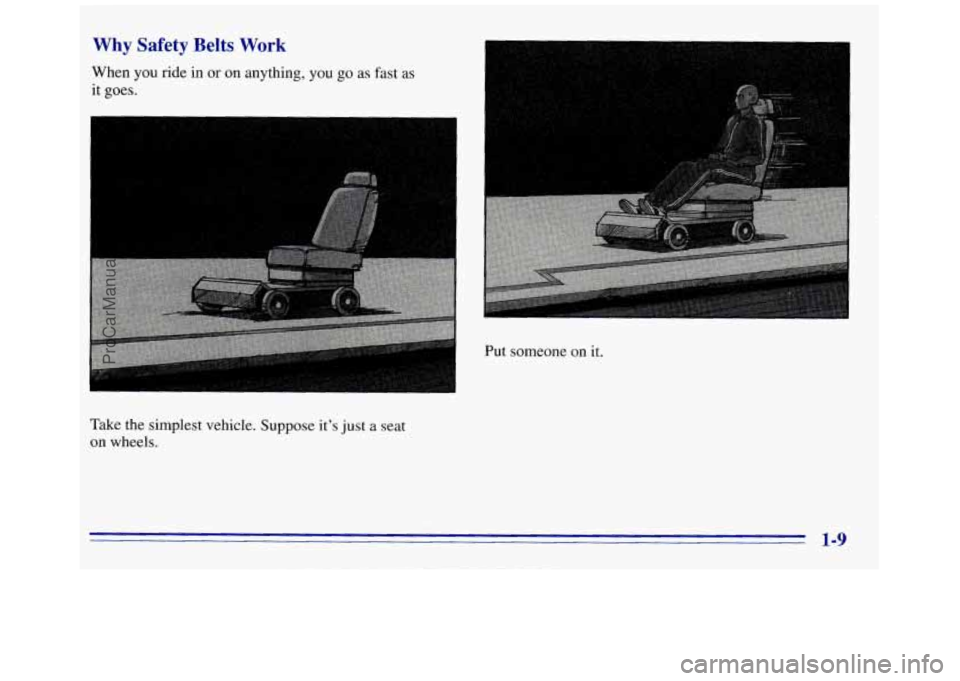
Why Safety Belts Work
1
. . . -.. ,
Take the simplest vehicle. Suppose it's just a seat
on wheels. Put someone on
it.
1-9
ProCarManuals.com
Page 18 of 372
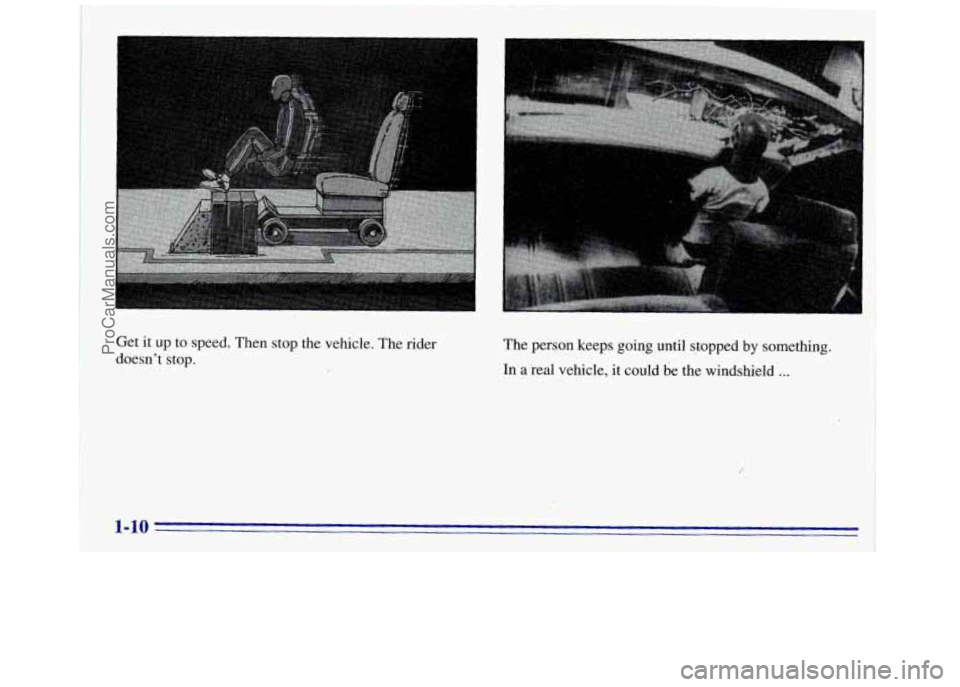
Get it up to speed. Then stop the vehicle. The rider
doesn't stop. The
person keeps going until stopped by something.
In
a real vehicle, it could be the windshield ...
-i
1-10 'I
ProCarManuals.com
Page 19 of 372
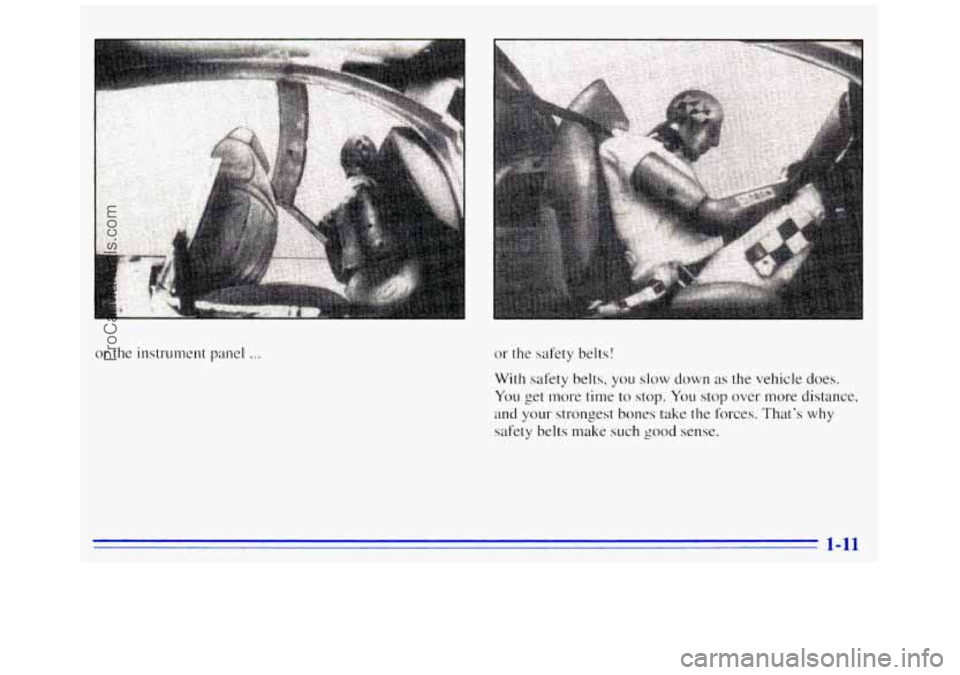
or the instrument panel ... or the safety belts!
With safety belts, you slow down as the vehicle does.
You get more
time to stop. YOLI stop over more distance,
and
your strongest bones take the forces. That’s why
safety belts make such
good sense.
ProCarManuals.com
Page 20 of 372
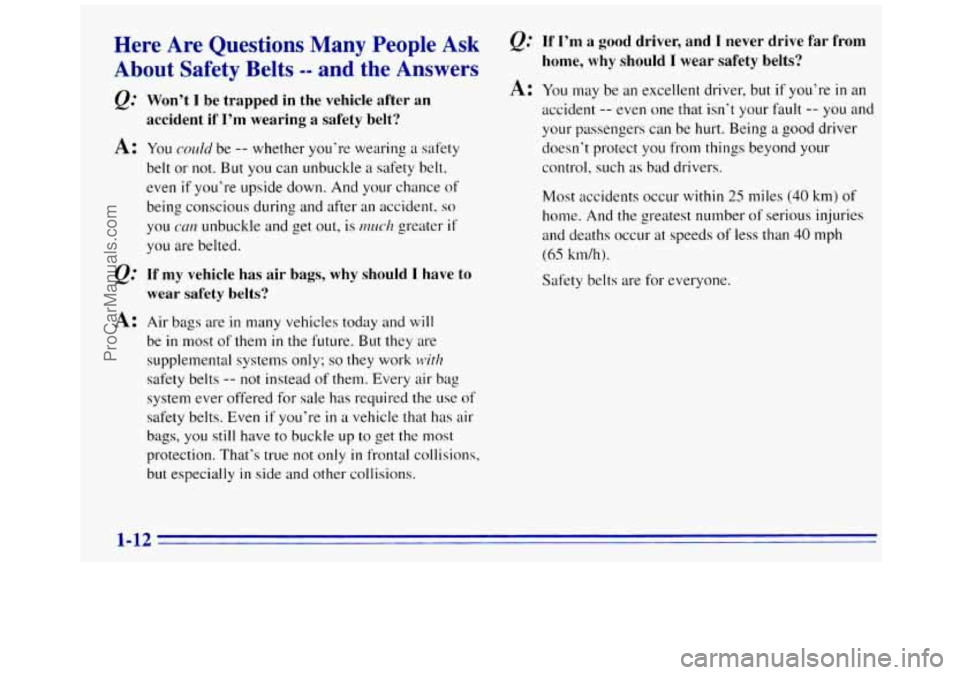
Here Are Questions Many People Ask Q: If I’m a good driver, and I never drive far from
About Safetv Belts -- and the Answers home, why should I wear safety belts?
Q:
A:
A:
U
Won’t I be trapped in the vehicle after an
accident if I’m wearing a safety belt?
You coclld be -- whether you’re wearing a safety
belt or not.
But you can unbuckle a safety belt,
even
if you’re upside down. And your chance of
being conscious during and after an accident,
so
you can unbuckle and get out, is IHLI~II greater if
you are belted.
If my vehicle has air bags, why should I have to
wear
safety belts?
Air bags are in many vehicles today and will
be in most of them in the future. But they are
supplemental systems only;
so they work cvith
safety belts -- not instead of them. Every air bag
system ever offered for sale has required the use of
safety belts. Even
if you’re in a vehicle that has air
bags,
you still have to buckle up to get the most
protection. That’s true not only
in frontal collisions.
but especially
in side and other collisions.
A: You may be an excellent driver, but if you’re in an
accident
-- even one that isn’t your fault -- you and
your passengers can be hurt. Being a good driver
doesn’t protect you from things beyond your
control, such as bad drivers.
Most accidents occur within
25 miles (40 km) of
home. And the greatest number of serious injuries
and deaths occur at speeds
of less than 40 mph
(65 ktn/h).
Safety belts are for everyone.
1-12
ProCarManuals.com